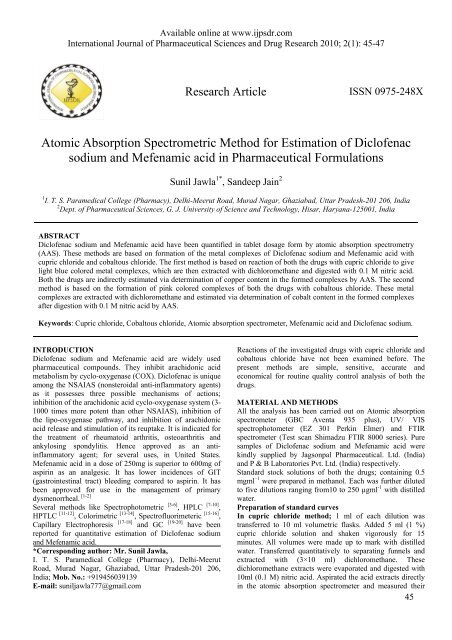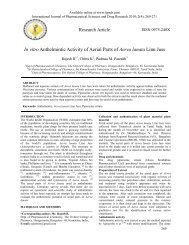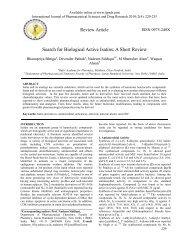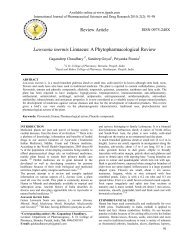Atomic Absorption Spectrometric Method for Estimation
Atomic Absorption Spectrometric Method for Estimation
Atomic Absorption Spectrometric Method for Estimation
Create successful ePaper yourself
Turn your PDF publications into a flip-book with our unique Google optimized e-Paper software.
Available online at www.ijpsdr.comInternational Journal of Pharmaceutical Sciences and Drug Research 2010; 2(1): 45-47Research Article ISSN 0975-248X<strong>Atomic</strong> <strong>Absorption</strong> <strong>Spectrometric</strong> <strong>Method</strong> <strong>for</strong> <strong>Estimation</strong> of Diclofenacsodium and Mefenamic acid in Pharmaceutical FormulationsSunil Jawla 1* , Sandeep Jain 21 I. T. S. Paramedical College (Pharmacy), Delhi-Meerut Road, Murad Nagar, Ghaziabad, Uttar Pradesh-201 206, India2 Dept. of Pharmaceutical Sciences, G. J. University of Science and Technology, Hisar, Haryana-125001, IndiaABSTRACTDiclofenac sodium and Mefenamic acid have been quantified in tablet dosage <strong>for</strong>m by atomic absorption spectrometry(AAS). These methods are based on <strong>for</strong>mation of the metal complexes of Diclofenac sodium and Mefenamic acid withcupric chloride and cobaltous chloride. The first method is based on reaction of both the drugs with cupric chloride to givelight blue colored metal complexes, which are then extracted with dichloromethane and digested with 0.1 M nitric acid.Both the drugs are indirectly estimated via determination of copper content in the <strong>for</strong>med complexes by AAS. The secondmethod is based on the <strong>for</strong>mation of pink colored complexes of both the drugs with cobaltous chloride. These metalcomplexes are extracted with dichloromethane and estimated via determination of cobalt content in the <strong>for</strong>med complexesafter digestion with 0.1 M nitric acid by AAS.Keywords: Cupric chloride, Cobaltous chloride, <strong>Atomic</strong> absorption spectrometer, Mefenamic acid and Diclofenac sodium.INTRODUCTIONDiclofenac sodium and Mefenamic acid are widely usedpharmaceutical compounds. They inhibit arachidonic acidmetabolism by cyclo-oxygenase (COX). Diclofenac is uniqueamong the NSAIAS (nonsteroidal anti-inflammatory agents)as it possesses three possible mechanisms of actions;inhibition of the arachidonic acid cyclo-oxygenase system (3-1000 times more potent than other NSAIAS), inhibition ofthe lipo-oxygenase pathway, and inhibition of arachidonicacid release and stimulation of its reuptake. It is indicated <strong>for</strong>the treatment of rheumatoid arthritis, osteoarthritis andankylosing spondylitis. Hence approved as an antiinflammatoryagent; <strong>for</strong> several uses, in United States.Mefenamic acid in a dose of 250mg is superior to 600mg ofaspirin as an analgesic. It has lower incidences of GIT(gastrointestinal tract) bleeding compared to aspirin. It hasbeen approved <strong>for</strong> use in the management of primarydysmenorrheal. [1-2]Several methods like Spectrophotometric [3-6] , HPLC [7-10] ,HPTLC [11-12] , Colorimetric [13-14] , Spectrofluorimeteric [15-16] ,Capillary Electrophoresis [17-18] and GC [19-20] have beenreported <strong>for</strong> quantitative estimation of Diclofenac sodiumand Mefenamic acid.*Corresponding author: Mr. Sunil Jawla,I. T. S. Paramedical College (Pharmacy), Delhi-MeerutRoad, Murad Nagar, Ghaziabad, Uttar Pradesh-201 206,India; Mob. No.: +919456039139E-mail: suniljawla777@gmail.comReactions of the investigated drugs with cupric chloride andcobaltous chloride have not been examined be<strong>for</strong>e. Thepresent methods are simple, sensitive, accurate andeconomical <strong>for</strong> routine quality control analysis of both thedrugs.MATERIAL AND METHODSAll the analysis has been carried out on <strong>Atomic</strong> absorptionspectrometer (GBC Aventa 935 plus), UV/ VISspectrophotometer (EZ 301 Perkin Elmer) and FTIRspectrometer (Test scan Shimadzu FTIR 8000 series). Puresamples of Diclofenac sodium and Mefenamic acid werekindly supplied by Jagsonpal Pharmaceutical. Ltd. (India)and P & B Laboratories Pvt. Ltd. (India) respectively.Standard stock solutions of both the drugs; containing 0.5mgml –1 were prepared in methanol. Each was further dilutedto five dilutions ranging from10 to 250 µgml -1 with distilledwater.Preparation of standard curvesIn cupric chloride method; 1 ml of each dilution wastransferred to 10 ml volumetric flasks. Added 5 ml (1 %)cupric chloride solution and shaken vigorously <strong>for</strong> 15minutes. All volumes were made up to mark with distilledwater. Transferred quantitatively to separating funnels andextracted with (3×10 ml) dichloromethane. Thesedichloromethane extracts were evaporated and digested with10ml (0.1 M) nitric acid. Aspirated the acid extracts directlyin the atomic absorption spectrometer and measured their45
Jawla et al. / <strong>Atomic</strong> <strong>Absorption</strong> <strong>Spectrometric</strong> <strong>Method</strong> <strong>for</strong> <strong>Estimation</strong> ……………….absorbance at 324.8 nm <strong>for</strong> copper. Standard curves weregenerated <strong>for</strong> both the drugs by using regression analysis(Table 1).In cobaltous chloride method; 1 ml of each dilution wastransferred to 10 ml volumetric flasks. Added 5 ml (1 %)cobaltous chloride reagent and heated at 60 o C <strong>for</strong> 15 minutes.Added 1ml (0.5 %) triethanolamine reagent and madevolume up to mark with distilled water. Transferredquantitatively to separating funnels and extracted with (3×10ml) dichloromethane. Dichloromethane extracts wereevaporated and digested with 10 ml (0.1 M) nitric acid.Aspirated the acid extracts directly in the atomic absorptionspectrometer and measured their absorbance at 240.7 nm <strong>for</strong>cobalt. Standard curves were generated <strong>for</strong> both the drugs byusing regression analysis (Table 2).Table 1: Quantitative parameters <strong>for</strong> the determination of Diclofenacsodium and Mefenamic acid with cupric chloride methodBulk drugLinearity rangeCorrelationobserved (µgml -1 Intercept Slope)CoefficientDiclofenacsodium1.5-22.5 0.024 0.016 0.998Mefenamicacid2.5-23.0 0.013 0.017 0.996Table 2: Quantitative parameters <strong>for</strong> the determination of Diclofenacsodium and Mefenamic acid with cobaltous chloride methodBulk drugLinearity rangeCorrelationobserved (µgml -1 Intercept Slope)CoefficientDiclofenacsodium1.2-21.0 0.051 0.032 0.998Mefenamicacid3.0-24.5 0.084 0.021 0.997Table 3: Determination of the Diclofenac sodium (D) and Mefenamic acid(M) in tablets by cupric chloride methodSampleLabel Amount %age ofCoefficient PercentaClaimed Found Labelofge(mg / (mg/ ClamedVariation* Recoverytablet) tablet) FoundBrand I(D)50 50.17 100.34 0.42 100.37BrandII (D)50 49.88 99.76 0.39 99.67BrandIII (D)50 50.37 100.74 0.87 100.53BrandIV (M)500 500.70 100.14 0.37 100.26BrandV (M)500 501.90 100.38 0.68 100.21BrandVI (M)500 499.20 99.82 0.57 99.46*Mean of three estimationsTable: 4 Determination of Diclofenac sodium (D) and Mefenamic acid(M) in tablet dosage <strong>for</strong>m by cobaltous chloride methodSampleLabel Amount %age ofCoefficient PercentaClaimed Found Labelofge(mg / (mg/ ClamedVariation* Recoverytablet) tablet) FoundBrand I(D)50 49.92 99.84 0.82 99.85BrandII (D)50 50.14 100.28 0.68 100.30BrandIII (D)50 49.87 99.74 0.87 99.87BrandIV (M)500 502.20 100.44 0.73 100.76BrandV (M)500 499.80 99.96 0.48 99.56BrandVI (M)500 501.30 100.26 0.55 100.47*Mean of three estimationsPreparation and analysis of tablet sample solutionTwenty tablets were weighed and crushed to fine powderseparately <strong>for</strong> Diclofenac sodium and Mefenamic acid.Weighed accurately an amount of the powdered tabletsequivalent to 10 mg of each drug, shaken with (3×10 ml)methanol; filtered and washed. Reduced the volume of thesolvent up to about 6 ml by evaporation. Transferredquantitatively into 10 ml volumetric flasks and completed tovolume with distilled water. Made suitable dilutions to carryout analysis by AAS (Table 3 & 4).RESULTS AND DISCUSSIONPharmaceutical analysts are now using metal ions <strong>for</strong> theestimation of different pharmaceutical <strong>for</strong>mulations byapplying AAS. It provided an indirect method <strong>for</strong>determination of the investigated drugs. In cupric chloridemethod; Diclofenac sodium and Mefenamic acid can bedetermined in the concentration ranges 1.5-22.5 and 2.5-23.0µgml –1 with mean percentage recovery of 100.19 ± 0.47 %and 100.31 ± 0.79 % respectively. In cobaltous chloridemethod; Diclofenac sodium and Mefenamic acid can bemeasured in the concentration ranges 3.5-21.0, 3.0-24.5µgml –1 with mean percentage recovery of 99.92 ± 0.15 %and 100.26 ± 0.76 % respectively in cobaltous chloridemethod. Linearity is obeyed in both the methods in the givenconcentration ranges. These methods were also applied topharmaceutical <strong>for</strong>mulations of both the drugs as shown inTable (3 & 4) along with recovery studies.These methods can be employed <strong>for</strong> routine analysis ofDiclofenac sodium and Mefenamic acid in quality controllaboratories. Hence the aim of development of simple,precise, sensitive and economical methods gets fulfilled.REFERENCES1. Ronald Borne F, David Williams A. Thomas Lemake L. Foye’sPrinciples of Medicinal Chemistry. Edn 5, Wolters Kluwer Health(India) Pvt. Ltd., New Delhi, 2002, pp. 751- 790.2. Hardman G, Limbird Lee E. Goodman and Gilman’s ThePharmacological Basis of Therapeutics. Edn 10, Mc Graw-Hill,Medical Publishing Division, New York, 2001, pp. 709-711.3. Agatonovic-Kustrin, S, Zivanovic L, Zecevic M, Radulovic D.Spectrophotometric study of diclofenac-iron (III) complex.Analytical letters. 1997; 30(12): 2235-2249.4. Botello JC, Perex-Caballero G. Spectrophotometric determinationof declofenac sodium with methylene blue. Indian Drugs. 1995; 32(4): 194-196.5. Dinc E, Yucesoy C, Onur F. Simultaneous Spectrophotometricdetermination of mefenamic acid and paracetamol in apharmaceutical preparation using ratio spectra derivativespectrophotometry and chemometric methods. Journal ofPharmaceutical and Biomedical Analysis, 2002; 28 (6): 1091-1100.6. Das S, Sharma SC, Talwar SK, Sethi PD. Simultaneousspectrophotometric determination of mefenamic acid andparacetamol in pharmaceutical preparations. Analyst (London).1989; 114 (1): 101-103.7. Malliou ET, Markopoulou CK, Koundourellis JE. Simultaneousdetermination of clobutinol together with some anti-inflammatorydrugs in urine by HPLC. Journal of Liquid Chromatography &Related Technologies. 2004; 27 (10): 1565-1577.8. Sun Y, Takaba K, Kido, H, Nakashima, MN, Nakashima, K.Simultaneous determination of arylpropionic acid non-steroidalanti-inflammatory drugs in pharmaceutical <strong>for</strong>mulations and humanplasma by HPLC with UV detection. Journal of Pharmaceutical andBiomedical Analysis. 2003; 30 (5): 1611-1619.9. Rouini MR, Asadipour A, Ardakani YH, Aghdasi F. Liquidchromatography method <strong>for</strong> determination of mefenamic acid inhuman serum. Journal of Chromatography, B: AnalyticalTechnologies in the Biomedical and Life Sciences. 2004; 800(1-2):189-192.IJPSDR January-March, 2010, Vol 2, Issue 1 (45-47) 46
Jawla et al. / <strong>Atomic</strong> <strong>Absorption</strong> <strong>Spectrometric</strong> <strong>Method</strong> <strong>for</strong> <strong>Estimation</strong> ……………….10. Cerretani D, Micheli L, Fiaschi AI, Giorgi G. High-per<strong>for</strong>manceliquid chromatography of flufenamic acid and mefenamic acid inrat plasma. Journal of Chromatography, B: BiomedicalApplications. 1996; 678(2): 365-368.11. Dorado P, Berecz R, Caceres MC, Llerena A. Sensitive HPTLCmethod <strong>for</strong> monitoring dissolution profiles of diclofenac fromdifferent tablets containing combined diclofenac andacetaminophen. Journal of Chromatography, B.AnalyticalTechnologies in the Biomedical and Life Sciences. 2003; 89(2):437-442.12. Argekar AP, Sawant JG. Simultaneous determination ofparacetamol and mefenamic acid in tablets by HPTLC. JournalPlanar Chromatography-Modern TLC. 1999; 12(5): 361-364.13. Mathur SC, Kumar Y, Prasad Rao PBN, Rathore ACS, Gupta YKS,A simple colorimetric estimation of diclofenac sodium in dosage<strong>for</strong>ms. Indian Drugs. 1994; 31(9): 447-448.14. El-Sherif ZA, Walash MI, El-Tarras MF, Osman AO, Colorimetricdetermination of two nonsteroidal anti-inflammatory drugs using p-dimethylamino cinnamaldehyde. Analytical Letters. 1997; 30(10):1881-1896.15. Arancibia JA, Boldrini MA, Escandar GM, Spectrofluorimetricdetermination of diclofenac in the presence of cyclodextrin.Talanta. 2000; 52(2): 261–268.16. Ioannou PC, Rusakova NV, Andrikopoulou DA, Glynou KM,Tzompanaki GM. Spectrofluorimetric determination of anthranilicacid derivatives based on terbium-sensitized fluorescence. Analyst(Cambridge, U. K.). 1998; 123(12): 2839-2843.17. Macia A, Borrull F, Aguilar C, Calull M. Improving sensitivity bylarge-volume sample stacking using the electroosmotic flow pumpto analyse some nonsteroidal anti-inflammatory drugs by capillaryelectrophoresis in water samples. Electrophoresis. 2003; 24(16):2779-2787.18. Wei W, Ju HX. Affinity capillary electrophoresis studies on theinfluence of alcohols on the interaction of β-cyclodextrin with nonsteroidalanti-inflammatory drugs. Chromatographia. 2003; 57(7-8):449-453.19. Sioufi A, Pommier F, Godbillon J. Determination of diclofenac inplasma and urine by capillary gas chromatography – massspectrometry with possible simultaneous determination ofdeuterium-labelled diclofenac. J.Liq. Chromatoger. 1994; 17(5):1065-1088.20. Reddersen K, Heberer T. Multi-compound methods <strong>for</strong> thedetection of pharmaceutical residues in various waters applyingsolid phase extraction (SPE) and gas chromatography with massspectrometric (GC-MS) detection. Journal of Separation Science.2003; 26(15-16): 1443-1450.IJPSDR January-March, 2010, Vol 2, Issue 1 (45-47) 47






